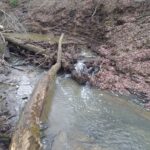By Uriah St. John, Seasonal Naturalist

Many of you have no doubt heard about the cargo ship that got stuck in the Suez Canal earlier this year, backing up everything trying to sail through the canal. A similar thing happens in natural streams and rivers, except it’s a good thing! The “ships” in this case are fallen branches or tree trunks, referred by ecologists as large wood or woody debris. Large wood just means any piece of wood in the river at least 4in thick and 6ft long.
Large wood is great for streams for a number of reasons, but the first is that they mix things up. When there’s large wood stuck in a stream it forces the water to slow down or go around it. This change in the water speed and direction creates new habitat for fish and invertebrates living there. Many fish and insects are very picky, preferring fast riffles or slow pools, and the large wood helps break up the stream to give both groups their niche.
Another great benefit of large wood is that it helps slow stream erosion. Since the water must slow down and flow around the wood, its force on the stream banks is reduced which leads to less sediment being carried away. This is even more impactful during storms when the stream swells. In slowing the flow of the stream the large wood creates a pileup behind it which pushes the stream onto its flood plain. This can slow the water enough that it will drop the sediment it has already carried away onto the floodplain providing rich soil for trees, shrubs, and other plants growing there.
Large wood also forms one of the bases for the entire stream food web. The wood is colonized and broken down by fungi and bacteria which is in turn eaten by insects and other invertebrates. These invertebrates are then eaten by fish and so on up the food chain. That’s not the only way large wood adds to the food chain though! When the logs and branches get stuck they form a “net”, which helps catch smaller branches and leaves. These smaller pieces of debris are eaten by a group of invertebrates known as shredders, who grind leaves and smaller pieces of wood and eat them. This recycles the nutrients in the wood and provides another group of herbivorous invertebrates for predators to feed on. While old tree trunks and branches stuck in streams might not look great, they are a bedrock for healthy streams and help create more habitat and food in streams.






